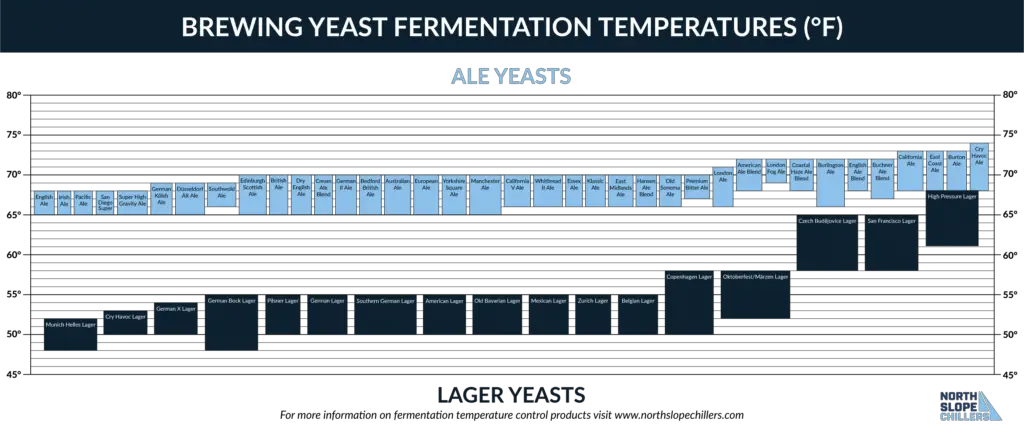Beer, one of the world’s most beloved beverages, has captivated our taste buds and brought people together for centuries. Its diverse range of flavors, aromas, and textures can be attributed to the various brewing techniques employed throughout history.
Among these methods, two distinctive fermentation processes have emerged as the foundation for countless beer styles: top fermentation and bottom fermentation.
In this blog post, we’ll delve into the fascinating world of beer brewing and explore the differences between top fermented and bottom fermented beers.
Whether you’re a beer aficionado, an aspiring homebrewer, or simply curious about the art behind your favorite pint, this guide will shed light on the distinct characteristics and brewing methods associated with each fermentation style.

Prepare to embark on a flavorful journey as we unravel the mysteries behind top fermented and bottom fermented beers. From traditional ales to classic lagers, understanding the nuances of these brewing techniques will deepen your appreciation for the incredible range of flavors found in the world of beer.
The Science Behind Fermentation
Yeast: The Unseen Hero
Yeast is a single-celled microorganism responsible for converting sugars into alcohol and carbon dioxide during the fermentation process.
There are hundreds of yeast strains, but the two primary types used in brewing are Saccharomyces cerevisiae (top-fermenting yeast) and Saccharomyces pastorianus (bottom-fermenting yeast). These yeast strains have different characteristics, resulting in distinct beer styles.
How Temperature Affects Fermentation
The most significant factor that determines whether a beer is top or bottom fermented is the temperature at which the yeast ferments the sugars. Top-fermenting yeast strains perform best at higher temperatures, typically between 60°F and 75°F (15°C and 24°C).
This temperature range encourages more active yeast, causing it to rise to the surface during fermentation. In contrast, bottom-fermenting yeast strains prefer cooler temperatures, usually between 45°F and 55°F (7°C and 13°C).
These lower temperatures result in a slower, more controlled fermentation with the yeast settling at the bottom of the vessel.
Ale Vs. Lager Yeast Strains
Ale and lager yeast are two distinct strains of yeast commonly used in the brewing industry to produce different types of beer.

They differ not only in terms of the flavors they impart but also in their optimal fermentation temperatures and the reasons behind these differences.
Ale Yeasts:
- Ale yeast, most being Saccharomyces cerevisiae, is a top-fermenting yeast strain. It ferments at warmer temperatures compared to lager yeast.
- Optimal fermentation temperature for ale yeast typically ranges from 60°F to 75°F (15°C to 24°C). Some ale yeast strains may even tolerate slightly higher temperatures.
- The warmer fermentation temperatures associated with ale yeast lead to a faster fermentation process. This results in a beer with a quicker turnaround time, often ready to drink in a matter of weeks.
- Ale yeast produces a wider range of flavors and aromas, including fruity esters and spicy phenols, which contribute to the complex and diverse flavor profiles found in ales. These flavors are often more pronounced due to the higher fermentation temperatures.
Lager Yeasts:
- Lager yeast, scientifically known as Saccharomyces pastorianus, is a bottom-fermenting yeast strain. It ferments at cooler temperatures compared to ale yeast.
- Optimal fermentation temperature for lager yeast typically ranges from 45°F to 55°F (7°C to 13°C). Some lager yeast strains may require even cooler temperatures, especially for traditional lager styles.
- The colder fermentation temperatures associated with lager yeast result in a slower fermentation process. Lager beers often require a longer maturation period, sometimes several months, to reach their optimal flavor.
- Lager yeast produces fewer esters and phenols compared to ale yeast. This results in a cleaner and crisper flavor profile with a focus on malt and hops characteristics. Lager beers are known for their subtlety and balance.
Why the Temperature Difference?
- The primary reason for the difference in optimal fermentation temperatures between ale and lager yeast lies in their evolutionary history and adaptation.
- Ale yeast strains have developed to thrive in warmer temperatures, as they were historically used in regions with milder climates. Their ability to ferment at higher temperatures allows for a quicker brewing process.
- Lager yeast strains, on the other hand, have adapted to cooler temperatures, often found in regions with cold winters and caves. Their slow, cool fermentation process contributes to the clean and crisp profile of lager beers.
- Temperature also influences the production of fermentation byproducts. Ale yeast, fermenting at warmer temperatures, generates more esters and phenols, while lager yeast, fermenting at cooler temperatures, minimizes these compounds.
In summary, ale and lager yeast are two distinct types of yeast with different optimal fermentation temperatures and flavor profiles.
These differences are rooted in their evolutionary history and adaptation to specific environmental conditions.
Brewers carefully select the yeast strain and fermentation temperature to achieve the desired characteristics in their beer, whether it’s a fruity and complex ale or a clean and crisp lager.
This makes them ideal for brewing in warmer climates or during the summer months when control over temperature might be challenging.
Characteristics of Top-Fermented Beers
Ales: Flavor and Complexity
Top-fermented beers, commonly known as ales, are known for their rich, complex flavors and aromas. The warmer fermentation temperature promotes the production of esters, which contribute to fruity and spicy notes in the finished beer. Additionally, ales tend to have a higher alcohol content due to the more aggressive yeast activity at higher temperatures.
Popular Ale Styles
There are countless ale styles, each with its unique characteristics. Some popular examples include:
1. India Pale Ale (IPA): Known for its hop-forward flavor profile and higher alcohol content, IPAs often showcase citrus, pine, or floral notes.
2. Stout: Dark and roasty, stouts often feature flavors of coffee, chocolate, and roasted malt.
3. Wheat Beer: Light and refreshing, wheat beers can showcase fruity, spicy, or tart characteristics depending on the yeast strain used.
Characteristics of Bottom-Fermented Beers
Lagers: Crisp and Clean
Bottom-fermented beers, more commonly known as lagers, are characterized by their crisp, clean flavors and smooth drinkability. The cooler fermentation temperature reduces the production of esters, resulting in a more subdued flavor profile with a focus on the malt and hop characteristics. Lagers also tend to have a lower alcohol content compared to ales due to the slower fermentation process.
Popular Lager Styles
As with ales, there are numerous lager styles to explore. Some popular examples include:
1. Pilsner: Crisp and refreshing, pilsners showcase a balance of malt sweetness and hop bitterness, often with a floral or spicy hop aroma.
2. Oktoberfest/Märzen: Rich and malty, these amber lagers feature a smooth, clean finish with a hint of hop bitterness.
3. Doppelbock: Strong and malty, doppelbocks showcase deep caramel and dark fruit flavors with a warming alcohol presence.
Brewing Techniques and Equipment
Brew-in-a-Bag (BIAB) and All-Grain Brewing
Regardless of whether you’re brewing a top-fermented ale or a bottom-fermented lager, the initial brewing process remains relatively consistent. Most homebrewers utilize either the Brew-in-a-Bag (BIAB) method or traditional all-grain brewing to produce their beer. Both methods involve mashing malted grains in hot water to extract sugars, boiling the resulting wort with hops, and then cooling it down before adding the yeast for fermentation.
Temperature Control for Fermentation
The key difference in brewing ales and lagers lies in temperature control during fermentation. For ales, maintaining a consistent temperature within the yeast’s preferred range is crucial for optimal flavor development. In contrast, lagers require more precise temperature control to maintain the cooler fermentation environment. Many homebrewers utilize fermentation chambers or temperature-controlled fridges to ensure their beers ferment at the desired temperature.
Choosing the Right Beer for You
As a homebrewer, it’s essential to consider your personal preferences, brewing equipment, and environment when deciding whether to brew a top-fermented ale or a bottom-fermented lager. If you enjoy rich, complex flavors and have the ability to maintain warmer fermentation temperatures, ales may be the perfect choice for you. On the other hand, if you prefer crisp, clean flavors and have the equipment to maintain cooler fermentation temperatures, lagers could be the way to go.
Conclusion
In summary, the main difference between top and bottom-fermented beers lies in the yeast strains and fermentation temperatures used during the brewing process. Here are ten key takeaways to remember:
1. Top-fermented beers are also known as ales.
2. Bottom-fermented beers are also known as lagers.
3. Saccharomyces cerevisiae is the primary yeast strain used for top fermentation, while Saccharomyces pastorianus is used for bottom fermentation.
4. Top fermentation occurs at higher temperatures (60°F to 75°F or 15°C to 24°C).
5. Bottom fermentation occurs at lower temperatures (45°F to 55°F or 7°C to 13°C).
6. Ales generally have more complex flavors and aromas due to ester production.
7. Lagers have a cleaner, crisper flavor profile with less ester production.
8. Brewing techniques, such as BIAB and all-grain brewing, are consistent across both top and bottom-fermented beers.
9. Temperature control during fermentation is crucial for both ales and lagers, though lagers require more precise control.
10. Choose the style of beer to brew based on your personal preferences, brewing equipment, and environmental factors.
Happy brewing!
FAQs
What are the 5 top-fermented beers?
The term “top-fermented” refers to the type of yeast used in the fermentation process of beer. Top-fermenting yeast strains, also known as ale yeast, typically ferment at warmer temperatures and rise to the top of the fermentation vessel. There are numerous styles of beer that utilize top-fermenting yeast, but here are five popular examples:
1. Pale Ale: Pale ales are characterized by their pale to amber color and prominent hop flavors. They often exhibit fruity esters and a moderate to high hop bitterness. Examples include American Pale Ale (APA) and English Pale Ale.
2. India Pale Ale (IPA): IPAs are known for their strong hop bitterness, higher alcohol content, and hop-forward aromas. They can range from golden to amber in color and often feature citrusy, floral, or resinous hop flavors.
3. Wheat Beer: Wheat beers, such as German Hefeweizen or Belgian Witbier, are brewed with a significant portion of wheat in addition to barley. They are typically light in color, hazy, and exhibit fruity, spicy, and sometimes clove-like flavors.
4. Belgian Strong Ale: Belgian Strong Ales encompass a wide range of styles, including Tripel, Dubbel, and Quadrupel. These beers are known for their high alcohol content, complex flavors, and often showcase fruity, spicy, and yeasty characteristics.
5. Porter: Porters are dark beers that originated in England. They feature roasted malt flavors, often with notes of chocolate, coffee, and caramel. Porters can range from robust and full-bodied to lighter and more sessionable variations.
It’s important to note that the classification of beer styles can vary, and there are numerous other top-fermented beers beyond these examples. The world of beer offers a wide variety of flavors and styles to explore.
Is Budweiser bottom-fermented?
Yes, Budweiser is a bottom-fermented beer.
What does top fermented beer mean?
Top fermented beer refers to a type of beer that is brewed using a yeast strain that ferments at the top of the fermentation tank. This type of yeast produces a range of flavors and aromas, including fruity and spicy notes, and is typically used in the production of ales and wheat beers. The fermentation process for top fermented beer is shorter than that of bottom fermented beer, and the resulting beer is often characterized by a fuller body and a higher alcohol content.
What beers are made by the bottom fermenting process?
Lagers are the beers that are made by the bottom fermenting process.
Is Corona bottom-fermented?
Yes, Corona is a bottom-fermented beer.
What is not considered a top-fermenting beer?
Bottom-fermenting beers, also known as lagers, are not considered top-fermenting beers.
What beers are bottom fermented?
Bottom-fermented beers are typically lagers, such as Pilsners, Bocks, and Dunkels.




